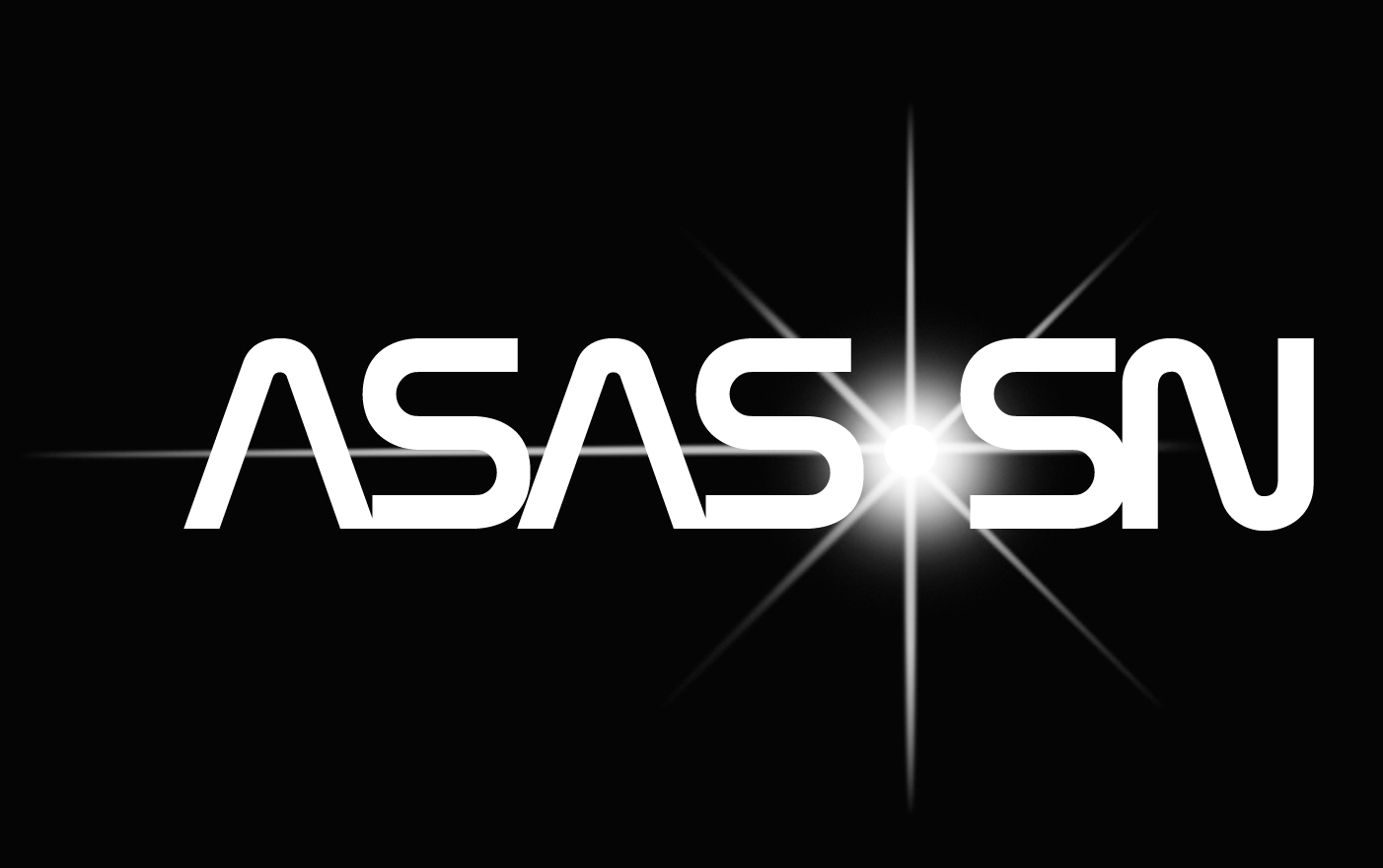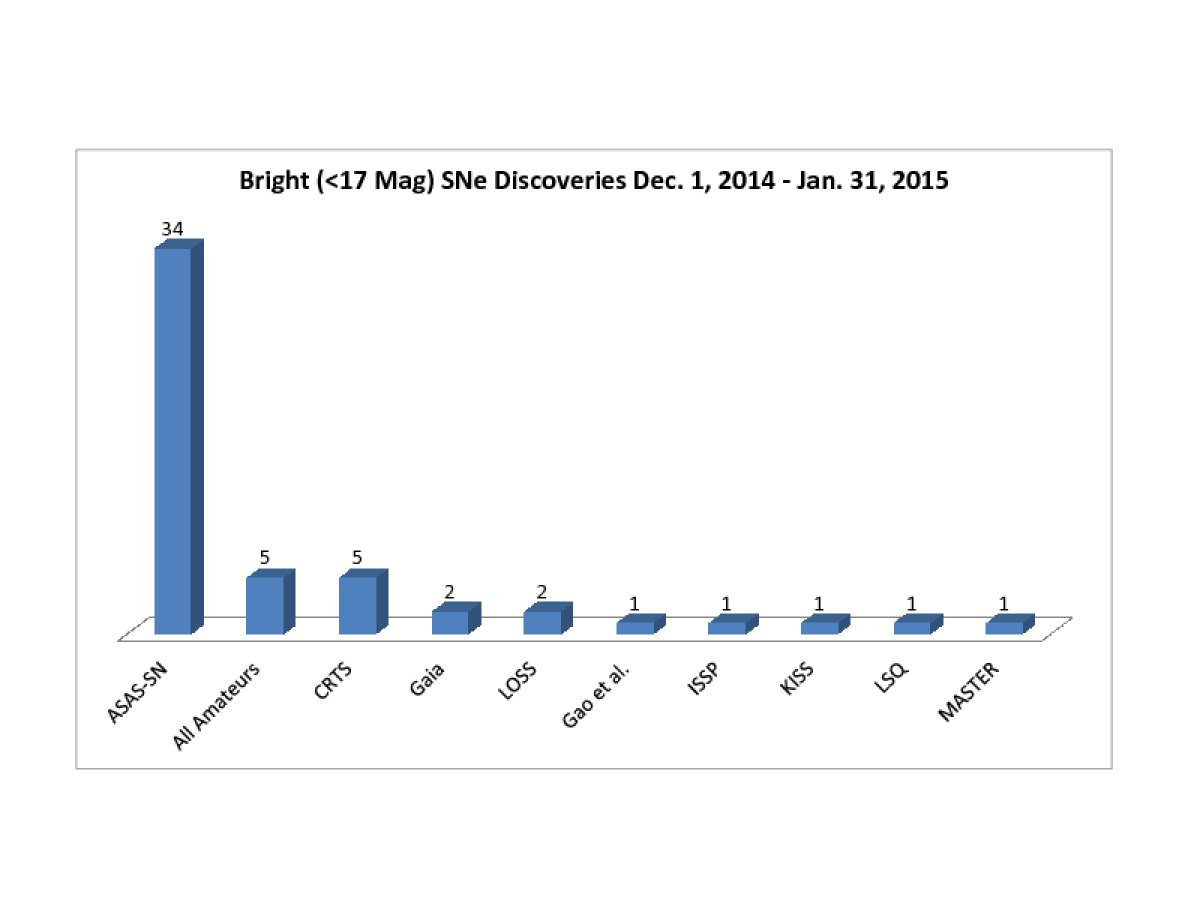
Assassin Picture of the Week
 | APOW Assassin Picture of the Week |

|
|
We have not updated this page (again) for a while now, being very busy discovering bright supernovae and many other transients. But it is good to take a break now and then and to check how one is doing (and it is just after Full Moon, which reduces our rate of discovery). As we described before, starting in May 2014 we have been finding 8-10 bright supernovae per month, so about half of all bright SNe discovered by all searches combined. However, in the last two months, our SNe discovery rate has increased significantly, basically doubling. This is illustrated in the plot above, which is using data from the Bright Supernova, a most useful website run by David Bishop. We select all the supernovae that peaked at 17.0 mag or above. Then we plot how many supernovae were discovered by different groups. There were 53 such SNe between December 1st, 2014 and January 31st, 2015, when we compiled the stats. Of that 53 SNe total, ASAS-SN discovered 34, amateur astronomers discovered 5, and all the other professional searches combined discovered 14. Obviously such split would not hold were we to look at fainter supernovae, where OGLE alone has reported about 50 SN candidates in 2015 to date. But bright and nearby SNe are especially valuable, as they and their host galaxies are easy to study using modest size, 1 to 4-m diameter telescopes. So what happened? There is more than one likely cause for this rapid improvement. Weather at both Chile and Hawaii LCOGT sites has been spectacular recently, allowing us to obtain good and frequent data for all the fields. As we take more data our overall data quality improves as well, due to ability to produce better reference images, which is crucial for our supernova search method. We have also added a machine-learning algorithm to evaluate candidate transients (written by Przemek Wozniak from Los Alamos), and that had the effect of both reducing our false positive rate and improving our ability to identify real transients. So while it took us between June 2013 and August 2014 to discover our first 50 SNe, we have discovered our 100th SN in January 2015, and our current SN count is 112. We should note that even when we are not the first to discover a given bright supernova, we eventually detect the majority of the rest. Will such an improvement continue? Time will tell, but we are optimistic. With a generous grant from Mt. Cuba Astronomical Foundation, Cassius will become a four-telescope unit by mid-2015, so that should further improve our cadence and discovery rate. Our long-term plan is to deploy 8 more telescopes at two new sites, allowing us to observe the entire sky once per day, with less dependence on weather at any given site. Starting in December 2014, we are now also observing the Galactic plane, a strategy that might not produce many bright supernovae (Galactic dust), but should produce plenty of new, exciting transients originating in the Milky Way. So, as always, stay tuned!
|
Back to ASAS-SN page.
See previous APOWs:
ASASSN-14lp: the Brightest Supernova Currently on the Sky
ASASSN-14li: Possible Tidal Disruption Event in Progress
ASASSN-13co: Type-Defying Luminous Type II Supernova
Bright Supernova Discoveries Statistics
Bright Supernovae: ASAS-SN Contribution
First Light on the Small Magellanic Cloud from Chile
Congratulations to Tom and Jacob!
ASASSN-13dn: Spectra from a New Instrument
ASASSN-14ae, A Very Luminous Transient
Our Latest Paper, in Video Form
Host Galaxies of ASAS-SN Supernovae
Back in Real-Time Discovery Business!
Active (Some Less, Some More) Galactic Nuclei with ASAS-SN
Swift
Ultraviolet and Optical Follow-Up of ASASSN-13dl, Our Latest
Supernova
Dramatic AGN Outburst in NGC 2617
Two ASAS-SN Views of Orion Nebula
AAVSO Observations of Cataclysmic Variable ASASSN-13ck
Two ASAS-SN Supernovae in One Day!
Extreme M-dwarf Flare Observed by ASAS-SN;
Multiband photometric follow-up of ASASSN-13aw (SN 2013dr);
How ASAS-SN Discovers Supernovae: Case of Supernova ASASSN-13bb;
NGC 2617: Dramatic Seyfert Type Change;
ASASSN-13/SN 2013da: Our First Supernova Three Weeks Later;
This homepage is maintained by Tom Holoien and Kris Stanek.
Updated Fri Feb 6 14:26:09 EST 2015